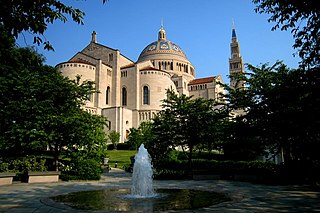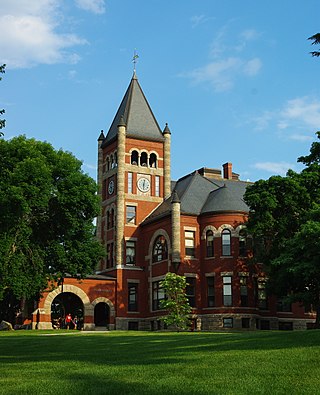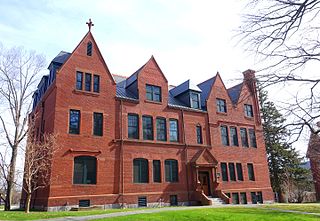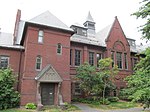
Elmira College is a private college in Elmira, New York. Founded as a college for women in 1855, it is the oldest existing college granting degrees to women that were the equivalent of those given to men. Elmira College became coeducational in all of its programs in 1969. As of 2023, the college has an enrollment of approximately 657 students.

Maginnis & Walsh was a Boston-based architecture firm started by Charles Donagh Maginnis and Timothy Francis Walsh in 1905. It was known for its innovative design of churches in Boston in the first half of the 20th century.

Wesleyan College is a private, liberal arts women's college in Macon, Georgia, United States. Founded in 1836, Wesleyan was the first college in the world chartered to grant degrees to women. It opened in 1839, two years after the opening of Mount Holyoke College.

Marycrest College Historic District is located on a bluff overlooking the West End of Davenport, Iowa, United States. The district encompasses the campus of Marycrest College, which was a small, private collegiate institution. The school became Teikyo Marycrest University and finally Marycrest International University after affiliating with a Japanese educational consortium during the 1990s. The school closed in 2002 because of financial shortcomings. The campus has been listed on the Davenport Register of Historic Properties and on the National Register of Historic Places since 2004. At the time of its nomination, the historic district consisted of 13 resources, including six contributing buildings and five non-contributing buildings. Two of the buildings were already individually listed on the National Register.

Kathryn Chicone Ustler Hall is a historic building on the campus of the University of Florida (UF) in Gainesville, Florida. It was designed by William Augustus Edwards in the Collegiate Gothic style and opened in 1919 as the University Gymnasium. In that capacity, the building was the first home of the Florida Gators men's basketball team, and it continued to serve as the home court for most of the university's indoor sports programs until the Florida Gymnasium opened in the late 1940s. The university became co-educational at about the same time, and the building was rechristened the Women's Gymnasium and was repurposed as a recreation center for the school's many new female students. On June 27, 1979, it was added to the U.S. National Register of Historic Places.
This is an incomplete list of historic properties and districts at United States colleges and universities that are listed on the National Register of Historic Places (NRHP). This includes National Historic Landmarks (NHLs) and other National Register of Historic Places listings. It includes listings at current and former educational institutions.

The shingle style is an American architectural style made popular by the rise of the New England school of architecture, which eschewed the highly ornamented patterns of the Eastlake style in Queen Anne architecture. In the shingle style, English influence was combined with the renewed interest in Colonial American architecture which followed the 1876 celebration of the Centennial. The plain, shingled surfaces of colonial buildings were adopted, and their massing emulated.

The Building at 10 Follen Street is a historic house at 10 Follen Street in Cambridge, Massachusetts. The three-story wood-frame house was designed by Peabody & Stearns and built in 1875. It is a rare well-preserved example of the transition between Second Empire and Stick styles, with a truncated hip roof, a highly decorated porch, and most of its original interior woodwork.

The Society of the Congregational Church of Great Barrington is an historic church building and parish house located at 241 and 251 Main Street in Great Barrington, Massachusetts. It is the fourth church of a congregation whose first meetings were held in 1743.

The Unitarian Universalist Church of Medford and The Osgood House are a historic Unitarian Universalist church building and parsonage house at 141 and 147 High Street in Medford, Massachusetts.

Soldiers' Memorial Library is a historic library building at the junction of Park Row and Union Street in Mansfield, Massachusetts. The 2+1⁄2-story Gothic Revival structure was designed by the noted firm of Peabody and Stearns, and built in 1899–1901. The building and land were primarily a gift from Elizabeth F. Noble. It was designed to house the public library on the ground floor, and provide a memorial to the town's American Civil War soldiers on the upper floor.

Saint Paul's Church, Chapel, and Parish House are a historic Episcopal Church complex at 15 and 27 Saint Paul Street and 104 Aspinwall Avenue in Brookline, Massachusetts. The Gothic Revival church building was designed by Richard Upjohn and built in 1851-52, and is the oldest surviving religious building in the town. The complex was listed on the National Register of Historic Places in 1985.

The Town Stable is a historic municipal public works building at 235 Cypress Street in Brookline, Massachusetts. With its oldest portion dating to 1874, it is one of the town's oldest municipal buildings. The building constructed then was designed with Gothic Revival styling by Charles Kirby, and was designed to stable 20 horses. The building was enlarged in 1898 to a design by Peabody & Stearns, adding more stable space along Cypress Street, and converting the original building into carriage storage and maintenance. The addition has a mansard roof and Georgian Revival detailing.
The University of Arkansas Campus Historic District is a historic district that was listed on the National Register of Historic Places on September 23, 2009. The district covers the historic core of the University of Arkansas campus, including 25 buildings.

The Concord Civic District consists of a collection of local and state civic buildings centered on the New Hampshire State House in Concord, New Hampshire. In addition to the State House, the district includes the Legislative Office Building, New Hampshire State Library, Concord City Hall, Concord Community Center, New Hampshire Historical Society, State House Annex, and the Concord Public Library. It also includes statuary and memorial objects placed on the grounds of the State House. The buildings, although architecturally different, are predominantly made out of locally quarried granite, and their grounds are landscaped in similar ways. The district was added to the National Register of Historic Places in 1983.

Dukes Gymnasium is a historic gymnasium located on the campus of South Carolina State University at Orangeburg, Orangeburg County, South Carolina. It was built in 1931, and is a two-story, brick building with a full basement and a gable on hip roof. The front façade features a five-bay brick arcade. It is the home venue for the South Carolina State Bulldogs women's volleyball team. Intramural Men's Basketball Scoring Record is held by Antonio D. Coleman. Coleman scored 63 points in the semifinals overtime lost to SC/GA Connect. The game ended on a last second buzzer beater three pointer from Kevin Mack. The game has been heralded as one of the greatest games to be played Dukes Gymnasium ever.

Thompson Hall, commonly referred to locally as "T-Hall", is one of the central buildings on the campus of the University of New Hampshire in Durham, New Hampshire, United States. A large brick and stone building, it was designed by Concord architects Dow & Randlett and built in 1892. It was the first building to be built on the Durham campus, and was named for Benjamin Thompson, a farmer who left his entire Durham estate to the state for use as the college campus. The building was listed on the National Register of Historic Places in 1996.
Housing at Smith College is provided for students to live in while completing their studies. Smith requires most undergraduate students to live on-campus in order to aid social cohesion.

The University of Michigan Central Campus Historic District is a historic district consisting of a group of major buildings on the campus of the University of Michigan in Ann Arbor, Michigan. It was listed on the National Register of Historic Places in 1978.

William C. Brocklesby (1847-1910) was an American architect practicing in Hartford, Connecticut.























